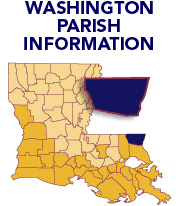Washington Parish--What HappenedOn August 29, 2005, Hurricane Katrina struck Washington Parish, Louisiana as a strong Category 4 storm. Katrina’s eye traveled on a northerly path through neighboring Mississippi from the Gulf Coast region towards Jackson; this brought the center of the eye to within 20 miles of Bogalusa, LA, the parish’s largest city. Residents and businesses began losing electrical power, water, telephone, cable television and internet service early that morning. Gale force winds were experienced in the parish by mid-morning. Hurricane force winds lasted 8 hours, with peak gusts recorded at 127 mph at Bogalusa. Several tornados were reported throughout the parish, causing extensive damage to the region’s timber industry. Storm surge was not an issue, as the parish is well inland. Hurricane conditions subsided approximately 12 hours after landfall.A small percentage of the population voluntarily evacuated before the storm. There was a limited mandatory evacuation for those who lived in mobile trailers mandated by the parish. Many fled the area as there was no electricity, phones or basic necessities due to extensive damage in the aftermath of the storm. All forms of communications, except for amateur ham radio and citizens band (CB), were out for 12 weeks. Power outages lasted from 30 to 60 days, creating critical situations for medical facilities and emergency personnel operating from short-term generators that eventually ran out of fuel. More than 100 nursing home residents from outside the parish were evacuated to shelters in parish schools that turned out to be ill-prepared and inadequate in terms of medical and treatment facilities. More than 22,000 parish residents, about one-half of the population, registered for federal assistance, 2,200 out of state. Over 5 percent of the residences received major damage, the majority of which are in low-income areas. Nine parish residents and one evacuee have been confirmed dead as a result of the storm or its aftereffects. One public official, the parish coroner, was put on medical leave after the storm: Dr. Roger Casama had to step down for a medical condition and he was replaced by Mr. Mike Varnado. |







